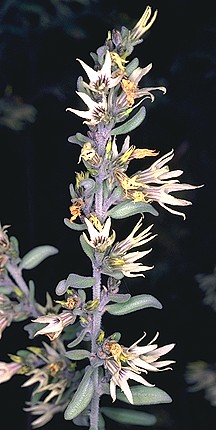
Synonymy
Cyphanthera albicans (Cunn.) Miers, Ann. Mag. Nat. Hist. ser. 2, 11: 379 (1853). subsp. albicans
Anthocercis albicans Cunn., in B. Field (ed.), Geogr. Mem. New South Wales 335, t. 2 (1825).
T: Bathurst, N.S.W., A. Cunningham 113/1822; lecto: K; iso: BM, K; fide Bentham, in DC., Prodr. 10: 192 (1846), by exclusion; `Peel's Range (now Cocoparra Range) near Griffith, N.S.W., A. Cunningham 240/1817; syn: BM, K.
Cyphanthera ovalifolia Miers, Ann. Mag. Nat. Hist. ser. 2, 11: 380 (1853).
T: `Nova Hollandia, W. McArthur — v.s. in herb. Hook. (Backhouse).’; holo: K.
Description
Erect shrub to 3 m, greyish. Branches granular-tomentose or pubescent with mainly dendritic, non-glandular hairs and scattered glandular hairs.
Leaves elliptic to ovate-elliptic or obovate-elliptic, almost sessile, 6–20 mm long, 1.5–7 mm wide, tomentose; juvenile leaves to 13 cm long, 4 cm wide.
Inflorescence panicle-like, dense, leafy; pedicels 1–6 mm long. Calyx 2–5.5 mm long, sparsely to densely pubescent. Corolla 6.5–13 mm long, glabrous to moderately pubescent outside with non-glandular hairs, white, cream or pale yellow, the striations purple; lobes ovate-truncate to almost linear, 3–15 mm long. Stamens 2–5 mm long.
Capsule globose to broadly ellipsoid, 2.5–8 mm long. Seeds 2.3–3.8 mm long.
Distribution and ecology
Occurs as small, often disjunct populations throughout the range of the species in the Great Dividing Range, from south-eastern Qld, through N.S.W. to north-eastern Vic.; not recently collected from Vic.
Grows in sclerophyll forest or shrub-land in sandy soils derived from sandstone, rarely from granite or aplite.
Common name
Grey Ray Flower
Notes
Geographically isolated populations show morphological differences.
Populations in south-eastern Qld with narrower and smaller leaves approach Anthocercis scabrella (Benth.) Miers, but may be distinguished by the unilocular anthers.
Distinction from other subspecies
Distinct from subsp. notabilis by its shorter leaves and corolla and less restricted distribution.
Distinct from subsp. tomentosa by its by its white or cream, rather than yellow, corolla and by the looser indumentum on the branches and leaves in which the hairs are 0.3-0.8 mm long, compared to the close tomentum of subsp. tomentosa in which the hairs are less than 0.3 mm long.
Phylogeny
Phylogenetic studies by Garcia & Olmstead (2003) on the Tribe Anthocercideae using two chloroplast DNA regions included this species The studies indicated that Cyphanthera is not monophyletic. Cyphanthers odgersii showed a closer relationship to Grammosolen while the rest of the Cyphanthera species combined to form a clade with Duboisia and Crenidium.
Reference: V.F.Garcia & R.G.Olmstead (2003). Phylogenetics of Tribe Anthocercideaea (Solanaceae) based on ndhF and trnL/F sequence data. Systematic Botany 28: 609-615.
Selected specimens
Qld: c. 44 km SW of Stanthorpe, V.K. Moriarty 505 (BRI). N.S.W.: c. 48 km SE of Rylstone, E.F. Constable 5114 (CANB, NSW, PERTH). Vic.: Berrima River, 1870, L. Calvert (MEL).
Derivation of epithet
From albicans, whitish, presumably a reference ot the overall appearance of the plant
Images and information on web
Further information and images of this species in NSW can be seen on the PlantNET site.
Pharmacology: A discussion of the tropane alkaloids which occur in Cyphanthera and other Anthocercideae can be found in Griffith & Lin (2000).
Ref: W.J. Griffin & G.D. Lin (2000). Chemotaxonomy and geographical distribution of tropane alkaloids. Phytochemistry 53: 627–628.

